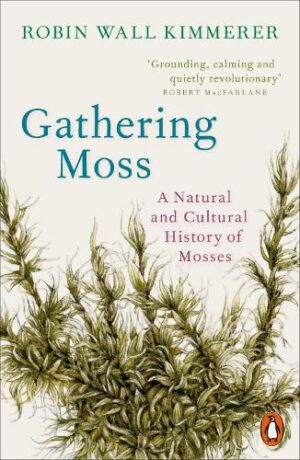First emerging from the oceans to live on land over 350 million years ago, the humble moss plant is an evolutionary pioneer. The natural world is blessed with an amazing 22,000 varieties, and yet its entry in the English Dictionary insults with its miserly wordage. The splendid Gathering Moss by Robin Wall Kimmerer seeks to introduce us to these beautiful ‘rainforests in miniature.’ A scientist and proud Native American, Kimmerer combines biology, cultural history and indigenous philosophy. In this deliciously unexpected bestseller, we learn not only the history of an unsung plant hero, but the forgotten practice of true attentiveness.
On discussing the unlikely success of her book, Kimmerer has been quoted as saying that she knows prospective readers may view mosses as uninteresting ‘little green scum on the rocks.’ Little do they know! Ranging across our world, tracing the letters on our gravestones, nestling in the tiniest stone folds of urban statues, and (quite literally) glittering in the darkest recesses of our caves, their complex sex lives and will to survive make them a fascinating subject.
And yet we barely notice their ubiquitous presence. Kimmerer suggests that although we’re used to seeing ‘what is beyond us’ with the aid of telescopes and microscopes, our untrained eyes are often unable to decipher light and patterns close at hand. What we may see as a bog standard ‘mossy’ rock may contain twenty different types, each with its own story; their collective green breath wearing the rock surface back to sand as slowly as ‘the drift of continents’.
We learn of their quirky reproductive habits. Using harvested moisture droplets, the sperm must surf a channel through the plant to the egg. Unfortunately the microscopic scale of the sperm means that the surface tension of the droplets resembles a bouncy castle, and while the sperm are bouncing, the water is rapidly evaporating. Very few of them make it, but incredibly, evolution has breezily blessed them with the ability to clone themselves or reproduce asexually.
This impressive will to survive is demonstrated again in the world’s arid spaces, where able to lose up to 98% of their moisture, they wait patiently for rain and dew, curled inwards upon themselves ‘as if suspended in daydreams’.
Interspersed with Kimmerer’s creative botanical experiments and research, are some interesting observations. Why, she wonders, is there so little information on our historical uses for moss? Once used as insulating lining for mittens and boots, they also served as lamp wicks, dish scrubbers, sanitary pads and diapers (certain types can absorb 20-40 times their weight in water). Was this little reported because historically, anthropologists were men and these were humdrum tools in the hands of women?
She reports too on the urban relationship to moss. Stress-resistant and adaptable, they are however, extremely sensitive to air pollution and may have fled some city streets. Take a look at your local tree population.
‘Mosses on the trees are a good sign, their absence a concern.’
Kimmerer tells us that sharing her bryologist’s knowledge often feels like being ‘a midwife to an awakening,’ a feeling that is surely reinforced by the success of this captivating book.
Gathering Moss by Robin Wall Kimmerer is published by Penguin, 192 pages.





